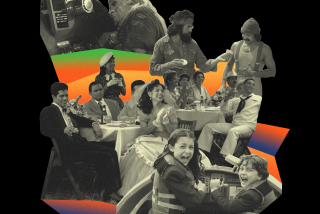
- Share via
A spate of documentaries focusing on the lives of Tejanos have found platforms over the last six months, showcasing how diverse, nuanced and entertaining our lives can be.
‘Going Varsity in Mariachi,’ the endearing documentary about the world of competitive high school mariachi in Texas, is finally available on streaming.
You can find the contemplative radicals of “Hummingbirds” trolling the streets of Laredo over on PBS; the determined detectives of “The Chicano Squad” solving crimes in Houston on A&E; and on Netflix, a dozen or so student musicians competing in “Going Varsity in Mariachi” and an aging grandfather building a home on the border in “What We Leave Behind.” On Max, the third episode of the Texas docuseries triptych “God Save Texas” takes an intimate and personal look at border life in El Paso, while Tubi has become the new home for “As I Walk Through the Valley,” an in-depth look at the history of rock ’n’ roll in the Rio Grande Valley.
And that’s just what you can stream right now. “The In Between,” a doc about grief and reconnection set in the small border town of Eagle Pass, is making its way through the festival circuit and is set to air on PBS next spring. Even Texas Monthly is executive producing a documentary about iconic Tejano television host Johnny Canales. (Disclosure: De Los editorial director Fidel Martinez is featured in this project.)

As a border native, I’ve become used to a specific kind of narrative when it comes to how my homeland is depicted onscreen, so this new wave of Tejano filmmaking is not only remarkable, it’s long overdue. But how did we get here?
The mainstreaming of Latino culture within the U.S. over the past decade has certainly helped, making it easier for filmmakers to convince streamers there’s an audience for their films. Alejandra Vasquez, a proud Tejana and one of the directors of the Sundance award-winning “Going Varsity in Mariachi,” admits that Bad Bunny and other superstars are helpful for the broader Latinx media consumption moment, but more specifically, she says, people are just tired of the same sad story about the border being told over and over again. You know the type (Disney’s National Geographic has been making shows like “Border Security: America’s Front Line” and “Border Wars” since 2010): dour tales about violence, the hazards of immigration, and the frustrating politics that follow.
“Those of us who grew up near the border and who are intimately familiar with the cross-cultural exchange that is so inherent of living on the border are like, ’Hey, that’s not the only story, that’s not the only side to this,” said Vasquez, adding that she and co-director Sam Osborn deliberately wanted to make an underdog sports movie where the balls and jerseys were swapped out for music and sombreros. “We wanted to have people on the edge of their seats.”

Mario Diaz, who directed “The Chicano Squad,” agrees that a fatigue has set in for audiences but says there’s also a desire to be entertained by the stories they’re consuming.
“Latin audiences want to have a good time,” Diaz says, noting that he worked hard to incorporate both the important cultural context of Mexican immigration in Houston with cool crime-solving swagger in “The Chicano Squad.”
Perhaps then the stale story of the border, the one of tragedy and turmoil, has created an ever-growing audience of filmgoers hungry for border stories that are both nuanced, and dare I say, fun?
“I just don’t think we’ve been given the opportunity to tell these stories before,” Diaz said. “Now, because of our own making, we’re pushing these stories out into the world.”
Diaz, who hails from Puerto Rico but who has taken a shine to Tejanos and our stories (his next project is also based in Texas), argues that this moment is more than just a trend, and that it is one of the community’s own making. Vazquez says a small group of like-minded Tejano artists have started a private network online to share resources and know-how and to connect experts to continue growing the field. “No one else is giving us that opportunity,” she says. “Once we get together, things happen. We’re like, OK, let’s do it, vamos!”
Charlie Vela lived the DIY filmmaking experience when he and co-director Ronnie Garza made 2017’s “As I Walk Through the Valley,” a head-banging sociological sojourn through the punk rock music history of the Rio Grande Valley. When the duo began filming in earnest back in 2015, neither had any professional experience with filmmaking. They did, however, have a deep understanding of their subject and a scrappy get-it-done-no-matter-what attitude.

“We did our film for no money,” said Vela. The goal, he added, was to tell the story and entertain his friends. “That’s how I’ve sort of approached anything creative I’ve ever done and it’s yielded surprising results.”
Vela was shocked when the film was accepted into that year’s South by Southwest Film Festival, where it premiered on his daughter’s first birthday to critical praise and national media attention. The movie never found a buyer, but through co-director Garza’s grit and determination, the film now has a home on Tubi, where millions can stream it for free.
“I’m just relieved it’s in a place where it’s accessible,” Vela says. “And folks don’t have to hit us up for a link anymore.”
Both Vela and Vasquez point to institutions like the Laredo Film Society and Entre, a Rio Grande Valley-based cooperative community film center, as important spaces where production teams can find local staffers for projects, filmmakers and artists can network and audiences can see different types of storytelling about the border. LFS has existed in some form since 2015, while Entre was founded in 2021.
“We’re helping to better define border stories and stories in this region,” says Entre co-founder Andres Sanchez. “A lot of folks tend to speak for the border and this community and use a lot of harmful rhetoric. We’re trying to do justice to this place we call home.”
Filmmaker and former LFS board member Karen Gaytán says these spaces play a critical role in sustaining and growing the movement, but that they are just a piece of the puzzle. “I don’t think we’re there yet,” she says, “but I think we’re seeing a very exciting genesis that I hope continues to grow.”
Everyone I talked to agreed that even with the success of this wave of filmmaking, there are still plenty of obstacles to overcome.
Vasquez says she and her “Going Varsity in Mariachi” team were lucky to find producers who came onboard early to support the production, but they struggled to sell or get distribution for the film. The documentary, she was told, was both too Mexican and not Mexican enough.
“We hear it over and over as Tejanos” she said. Eventually, they were able to secure a licensing deal with Netflix for 42 months, which Vasquez says has been a blessing.
Just making sure audiences know these stories are available is a challenge, says Diaz, whose A&E series is the rare exception: a network-backed story that got a full marketing push. More common, he says, are projects that are completed and then put out on a platform without so much as a whisper. “Even if productions are getting funded,” he says, “you’d never know about them. It puts the onus on the audience and the community.”
And so, even if we are in the golden age of Tejano documentary filmmaking, everything is not quite golden. This moment, however, does seem to have a name. Back in March, Carlos A. Gutiérrez, the executive director of Cinema Tropical, a New York-based nonprofit focused on highlighting Latin American cinema in the U.S., wrote about how multiple Tejano filmmakers were “defying hegemonic narratives,” dubbing this collective body of work as the “Border New Wave.” He says it can be traced as far back to 2014 when El Paso native Cristina Ibarra debuted “Las Marthas,” a film that follows Laredo’s high society set as they prepare for an annual debutante ball and pageant. The doc originally aired on PBS and is now available to stream on Kanopy. The marker signifies the beginning of a tidy decade of diverse Tejano films that are being seen by more people than ever.
“It adds up,” Vela says, creating more and more examples of success for executives to begin to understand the gradients of stories that make up the border. Not that Tejano filmmakers are making these films for executives anyway. “Even though the economics are complicated, I would hate for someone locally who wants to tell a story, but is discouraged because they think ‘Oh, I’ll never get it distributed,’” Vela says. “If you just want to make it, you can make it.”
It seems there’s no better time.
Luis G. Rendon is a Tejano journalist who lives in New York City and writes about South Texas food and culture. He’s been published in Texas Monthly, Texas Highways and the Daily Beast. You can find him on Twitter/X @louiegrendon and Instagram @lrendon.
More to Read
The Latinx experience chronicled
Get the Latinx Files newsletter for stories that capture the multitudes within our communities.
You may occasionally receive promotional content from the Los Angeles Times.







